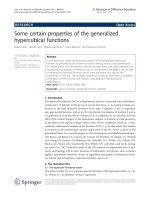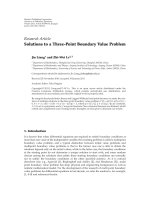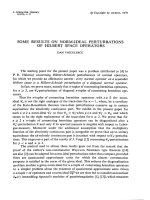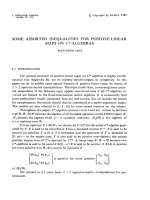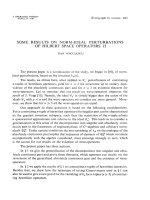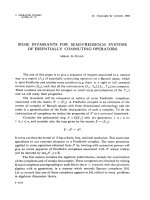Báo cáo toán học: "Some cyclic solutions to the three table Oberwolfach problem" pptx
Bạn đang xem bản rút gọn của tài liệu. Xem và tải ngay bản đầy đủ của tài liệu tại đây (81.65 KB, 7 trang )
Some cyclic solutions to the three table
Oberwolfach problem
M. A. Ollis
Marlboro College, South Road, Marlboro, VT 05344, USA
Submitted: Jun 2, 2005; Accepted: Nov 9, 2005; Published: Nov 15, 2005
Mathematics Subject Classification: 05C70
Abstract
We use graceful labellings of paths to give a new way of constructing terraces
for cyclic groups. These terraces are then used to find cyclic solutions to the three
table Oberwolfach problem, OP(r, r, s), where two of the tables have equal size. In
particular we show that, for every odd r ≥ 3 and even r with 4 ≤ r ≤ 16, there is
anumberN
r
such that there is a cyclic solution to OP(r, r, s) whenever s ≥ N
r
.
The terraces we are able to construct also prove a conjecture of Anderson: For all
m ≥ 3, there is a terrace of Z
2m
which begins 0, 2k,k, for some k.
1 Introduction
The Oberwolfach problem [6] is to decompose the complete graph K
v
, for odd v,into
mutually isomorphic 2-factors. If the lengths of the cycles in each 2-factor are r
1
,r
2
, ,r
t
(where r
1
+ r
2
···+ r
t
= v) then the problem is denoted OP(r
1
,r
2
, ,r
t
).
Label the vertices of K
v
with the symbols of Z
v−1
∪{∞},andletx + ∞ = ∞ for
x ∈ Z
v−1
. A solution to OP(r
1
,r
2
, ,r
t
) is called cyclic if x + F is a 2-factor whenever
F is a 2-factor and x ∈ Z
v−1
.
The goal of this paper is to find cyclic solutions for OP(r, r, s). Hilton and Johnson [9]
have shown that OP(r, r, s) has a solution for all odd s when r ∈{3, 4}, excluding the
insoluble case OP(3, 3, 5), and for all odd s ≥ 12r − 1whenr ≥ 5. These solutions are
not, in general, cyclic.
In this paper we show that for every odd r ≥ 3 and even r with 4 ≤ r ≤ 16 there is
anumberN
r
such that OP(r, r, s) has a cyclic solution whenever s ≥ N
r
. Our value for
N
r
is less than 12r − 1, so many of our solutions are to previously unsolved problems.
In particular, we show that OP(r, r, s) has a cyclic solution for every odd s ≥ 5when
3 ≤ r ≤ 13, excluding OP(3, 3, 5).
We now define terraces and graceful labellings—the two concepts that allow us to find
the solutions.
the electronic journal of combinatorics 12 (2005), #R58 1
Let G be a group of order n and a =(a
1
,a
2
, ,a
n
) an arrangement of the elements
of G. Define b =(b
1
,b
2
, ,b
n−1
), where b
i
= a
−1
i
a
i+1
.Ifb contains each involution of G
exactly once and two occurrences (not necessarily distinct) from each set {g, g
−1
: g
2
= e},
then a is called a terrace for G and b is the associated 2-sequencing. Terraces were
introduced in [3] to construct quasi-complete Latin squares. Elementary abelian 2-groups
of order at least 4 do not have terraces—Bailey’s Conjecture [3] is that these are the only
groups without terraces, see [11] for more details.
Let T be a tree on n vertices. Label the vertices of T with the integers 1, 2, ,n.
The labelling is called graceful if
{|u − v| : uv is an edge} = {1, 2, ,n− 1} .
The Ringel-Kotzig graceful tree conjecture is that all trees have a graceful labelling, see
[5] for the current state of knowledge.
2 Terraces from Graceful Labellings
For the remainder of the paper we consider only terraces for the additive cyclic groups
Z
n
(arithmetic modulo n) and graceful labellings of paths P
n
.
Given a terrace a of Z
n
then the translate x + a is a terrace, and has the same 2-
sequencing [3]. If the first element of a terrace is 0, then the terrace is called basic.Every
terrace may be translated to a basic terrace.
Example 2.1 The sequence (0, 1,n− 1, 2,n− 2, ) is a basic terrace for Z
n
[10, 13],
called the Lucas-Walecki-Williams terrace or LWW terrace. The associated 2-sequencing
is (1,n− 2, 3,n− 4, 5, ).
There is an easy way to get from a graceful labelling of P
n
, the path of length n,
to a terrace for the cyclic group Z
n
. Simply take the list of integers from the graceful
labelling, and consider them modulo n. The only change in symbols is that n becomes
0. The differences in the graceful labelling are exactly one of ±i (as integers) for each
integer i in the range 1 ≤ i ≤ n − 1. This satisfies the requirements of a terrace (when
taken modulo n). For example, the graceful labelling (n, 1,n− 1, 2,n− 2, ) becomes
the LWW terrace.
For Z
n
,ifa is a terrace, then −a and the reverse of a are also terraces [3]. Similarly
for P
n
, the reverse of a graceful labelling and the complementary labelling which replaces
i with n − i are also graceful.
A graceful labelling is called y-pendant if one of the pendant vertices is labelled y.The
following result gives a new construction of terraces.
Theorem 2.1 Suppose that P
m
and P
n
have y-pendant graceful labellings. Then Z
m+n
has a terrace.
the electronic journal of combinatorics 12 (2005), #R58 2
Proof: Suppose that the labelling of P
m
ends with y and that the labelling of P
n
starts
with y (this can be arranged by taking the reverses of given labellings if required), say
g =(g
1
,g
2
, g
m
)andh =(h
1
,h
2
, ,h
n
)whereg
m
= y = h
1
.
Let a =(a
1
,a
2
, ,a
m+n
), where
a
i
=
g
i
if i ≤ m
h
i−m
+ m if i>m.
The sequence a contains each of the numbers from 1 to m + n. Considering the elements
of a as integers, we have the differences ±i for 1 ≤ i ≤ m − 1(asg is graceful), followed
by m, and then the differences ±i for 1 ≤ i ≤ n − 1(ash is graceful). Taken modulo
m + n, this last is equivalent to ±i for m +1 ≤ m + n − 1. Altogether we have the
differences ±i for 1 ≤ i ≤ m + n − 1andsoa is a terrace for Z
m+n
.
The following result answers the existence question for y-pendant graceful labellings
of paths.
Theorem 2.2 [4, 7] There is a y-pendant graceful labelling of P
n
for every y ≤ n.
In [1], Anderson conjectured that for all even n the cyclic group Z
n
has a terrace which
begins 0, 2k,k, for some k ∈ Z
n
. It was shown that the truth of the conjecture implies
the existence of terraces for all dihedral groups. Later work [2] gave more complicated
constructions and proved that all dihedral groups have terraces without needing to prove
the conjecture. Theorem 2.3 implies that the conjecture is true, and hence the original
constructions are sufficient.
Theorem 2.3 There is a terrace which begins 0, 2, 1, for Z
n
if and only if n ≥ 3 and
n =4.
Proof: Clearly there is no terrace of the required form for n ∈{1, 2} and it is easy to
check that there is no such terrace for Z
4
.ForZ
3
, we have the terrace (0, 2, 1).
Now consider n ≥ 5. Let g be the 2-pendant graceful labelling (1, 3, 2) of P
3
and
let h be a 2-pendant graceful labelling of P
n−3
(such a labelling exists for all n ≥ 5by
Theorem 2.2).
Apply Theorem 2.1 to g and h with y = 2. We obtain a terrace for Z
n
of the form
(1, 3, 2, 5, ). The translate (n − 1) + (1, 3, 2, 5, )isthen(0, 2, 1, 4, ).
3 The Oberwolfach Problem
Before stating Theorem 3.1, which links terraces to the Oberwolfach Problem, we need
some more definitions.
Let a =(a
1
,a
2
, ,a
n
)beabasicterraceforZ
n
with 2-sequencing b =(b
1
,b
2
, ,b
n−1
).
If b
r
= a
r
then r is a left match-point of b. A left match-point is right-flexible if at least
one of the following is true.
the electronic journal of combinatorics 12 (2005), #R58 3
• n is even and
n
2
occurs somewhere to the right of b
r
in b
• There is an element x with ±x occuring to both somewhere to the left and somewhere
to the right of b
r
in b.
There are also the notions of right match-points and left-flexibility [12], but we do not
need them here.
Theorem 3.1 [12] If Z
n
has a 2-sequencing with a right-flexible left match-point r then
there is a cyclic solution to OP(r, r, s), where s =2(n − r)+1.
The construction which proves this theorem involves the “lifting” of a 2-sequencing to
a “symmetric sequencing” for the cyclic group of twice the size and then showing that the
associated terrace of this is a “symmetrically sectionable directed terrace.” The details
can be found in [12].
We now need to be able to construct terraces with left match-points (their right-
flexibility will be considered later).
Theorem 3.2 Let g =(g
1
,g
2
, ,g
m
) be a graceful labelling of P
m
with g
r
−g
1
= g
r+1
−g
r
,
for some r. Then Z
m+n
has a basic terrace with r as a left match-point of the associated
2-sequencing for n =0or n ≥ g
m
.
Proof: If n = 0, consider the elements of g modulo n and let a be the translate which is
basic. Then the 2-sequencing of a has r as a left match-point.
Now consider a fixed n ≥ g
m
.Leth be a g
m
-pendant graceful labelling of P
n
(this
exists by Theorem 2.2). Apply Theorem 2.1 to g and h to obtain a terrace for Z
m+n
.
Again, letting a be the translate which is basic, we get that the associated 2-sequencing
has r as a left match-point.
We are now in position to prove our main result.
Theorem 3.3 Let r =2k +1 and set N
r
=2
3k+1
2
+2k +3. There is a cyclic solution
to OP(r, r, s) whenever s ≥ N
r
.
Proof: Let g be the complementary labelling to the graceful labelling for P
m
which gives
the LWW terrace:
g =(1,n,2,n− 1, 3,n− 2, ,
m
2
+1)
If m =3k + 1 then we have g
2k+1
= k +1 andg
2k+2
=2k + 1. Hence
g
2k+2
− g
2k+1
= k = g
2k+1
− g
1
.
Take n ≥
m
2
+ 1. By Theorem 3.2 we can construct a basic terrace whose 2-sequencing
b has 2k + 1 as a left match-point. This left match-point is right flexible as −(k +1)
occurs in position 2k and ±(k + 1) occurs somewhere after position m.
Applying Theorem 3.1 now gives the result.
the electronic journal of combinatorics 12 (2005), #R58 4
To prove an analogous result for even r it would suffice to give a graceful labelling
(g
1
,g
2
, g
m
)ofP
m
with g
r+1
−g
r
= g
r
−g
1
, and to check that the required right-flexibility
property holds.
Table 1 gives some graceful labellings of P
m
for which g
r+1
− g
r
= g
r
− g
1
.Aswehave
all even values of r in the range 4 ≤ r ≤ 16, we have the result that there is a number
N
r
such that a cyclic solution to OP(r, r, s) exists whenever s ≥ N
r
for these values of
r. The table also includes some odd values of r for which the value of N
r
improves on
that of Theorem 3.3. Right-flexibility in the appropriate 2-sequencing is straightforward
to confirm.
Table 1: Some graceful labellings
r
m A graceful labelling of P
m
N
r
4 5 (2, 5, 1, 3, 4) 11
5
7 (3, 7, 1, 6, 4, 5, 2) 9
6
8 (4, 7, 1, 8, 3, 5, 6, 2) 9
7
9 (5, 2, 8, 1, 9, 4, 6, 7, 3) 11
8
10 (4, 7, 1, 10, 2, 9, 5, 6, 8, 3) 11
9
11 (5, 4, 10, 2, 11, 1, 8, 3, 7, 9, 6) 17
10
12 (3, 10, 4, 12, 1, 11, 2, 7, 8, 6, 9, 5) 15
11
13 (8, 3, 11, 5, 7, 4, 13, 1, 12, 2, 9, 10, 6) 17
12
14 (2, 12, 3, 14, 1, 13, 5, 11, 4, 9, 8, 6, 10, 7) 19
13
15 (4, 11, 3, 13, 2, 14, 1, 15, 6, 12, 8, 9, 7, 10, 5) 15
14
16 (8, 9, 5, 15, 3, 14, 1, 16, 2, 11, 6, 13, 7, 10, 12, 4) 13
16
17 (9, 5, 14, 4, 7, 12, 6, 13, 2, 15, 3, 17, 1, 16, 8, 10, 11) 25
To conclude, we collect together the old and new results on cyclic solutions to OP(r, r, s)
for small values of r.
Theorem 3.4 Except for the insoluble case OP(3, 3, 5), there is a cyclic solution to
OP(r, r, s) for all odd s ≥ 5 and each r in the range 3 ≤ r ≤ 13.
Proof: For r = 3, Theorem 3.3 gives N
r
= 9 and [12, Theorem 12] covers the case s =7.
Consider r in the range 4 ≤ r ≤ 8. Table 2 of [12] gives cyclic solutions for all s in
the range 5 ≤ s ≤ N
r
,whereN
r
is taken from Table 1.
For r in the range 9 ≤ r ≤ 13, Table 2 of [12] gives cyclic solutions for 5 ≤ s ≤ 31−2r.
Comparing with our Table 1, this leaves 14 outstanding cases. Of these, OP(11, 11, 11)
and OP(13, 13, 13) are covered in [8] and OP(12, 12, 13) by the comments on p. 408 of [12].
The remaining 11 cases can be solved by applying Theorem 3.1 to the terraces (whose
2-sequencings have right-flexible left match-points r) in Table 2. Several of these terraces
were found using the techniques and examples of [12]—where this is the case we indicate
the notation which describes them in that paper.
the electronic journal of combinatorics 12 (2005), #R58 5
Table 2: Some terraces for Z
m
r m A terrace for Z
m
s Notation
9 16 (0, 14, 5, 9, 4, 11, 3, 13, 1, 2, 15, 10, 7, 8, 6, 12) 15 −
10
16 (0, 1, 3, 13, 2, 6, 15, 12, 4, 7, 14, 10, 5, 11, 9, 8) 13 T
1
(8)
↑
11 17 (0, 8, 9, 14, 5, 3, 1, 7, 11, 4, 16, 15, 12, 2, 13, 10, 6) 13 −
18 (0, 4, 11, 15, 9, 1, 16, 17, 14, 7, 5, 10, 2, 3, 12, 6, 8, 13) 15 −
12
16 (0, 3, 5, 4, 13, 15, 11, 1, 6, 10, 2, 7, 14, 8, 9, 12) 9 −
17 (0, 13, 10, 8, 7, 2, 14, 4, 6, 3, 12, 16, 15, 9, 1, 11, 5) 11 rev(∆
1
12
(17))
19 (0, 1, 3, 6, 10, 15, 2, 9, 17, 7, 14, 16, 13, 5, 11, 12, 8, 18, 4) 15 ∆
14
(19)
20 (0, 3, 11, 12, 16, 7, 5, 18, 4, 9, 19, 14, 8, 15, 17, 6, 2, 1, 13, 10) 17 T
2
(10)
↑
13 16 (0, 10, 8, 11, 6, 4, 3, 12, 15, 7, 1, 5, 9, 2, 13, 14) 7 −
17 (0, 1, 3, 6, 10, 15, 4, 11, 2, 9, 13, 14, 12, 7, 16, 5, 8) 9 ∆
14
(17)
18 (0, 5, 7, 9, 15, 14, 6, 17, 12, 16, 13, 10, 4, 8, 1, 2, 11, 3) 11 −
References
[1] B.A. Anderson. Sequencings of dicyclic groups II. J. Combin. Math. Combin. Comp.,
3:5–27, 1988.
[2] B. A. Anderson. All dicyclic groups of order at least 12 have symmetric sequencings.
Contemp. Math., 111:5–21, 1990.
[3] R. A. Bailey. Quasi-complete latin squares: construction and randomization. J.
RoyalStatist.Soc.Ser.B, 46:323–334, 1984.
[4] E. Flandrin, I. Fournier, and A. Germa. Num´erotations gracieuses des chemins [grace-
ful enumerations of paths]. Ars. Combin., 16:149–181, 1983.
[5] J. A. Gallian. A dynamic survey of graph labellings. Electron. J. Combin.,Dynamic
Surveys(6):95pp, 2001.
[6] R. K. Guy. Unsolved combinatorial problems. In D. J. A. Walsh, editor, Combina-
torial mathematics and its applications (Proc. Conf. Oxford 1967), page 121, New
York, 1976. Academic Press.
[7] P. Gvozdjak. On the Oberwolfach Problem for Cycles with Multiple Lengths (PhD
thesis). Simon Fraser University, 2004.
[8] P. Hell, A. Kotzig, and A. Rosa. Some results on the Oberwolfach problem. Aequa-
tiones Math., 12:1–5, 1975.
[9] A. J. W. Hilton and M. Johnson. Some results on the Oberwolfach problem. J.
London Math. Soc., 64:513–522, 2001.
[10] E. Lucas. R´ecr´eations Math´ematiques, Tˆome II. Albert Blanchard, Paris, 1892.
reprinted 1975.
the electronic journal of combinatorics 12 (2005), #R58 6
[11] M. A. Ollis. Sequenceable groups and related topics. Electron. J. Combin.,Dynamic
Surveys(10):34pp, 2002.
[12] M. A. Ollis and D. A. Preece. Sectionable terraces and the (generalised) Oberwolfach
problem. Discrete Math., 266:399–416, 2003.
[13] E. J. Williams. Experimental designs balanced for the estimation of residual effects
of treatments. Aust. J. Scient. Res. A, 2:149–168, 1949.
the electronic journal of combinatorics 12 (2005), #R58 7

